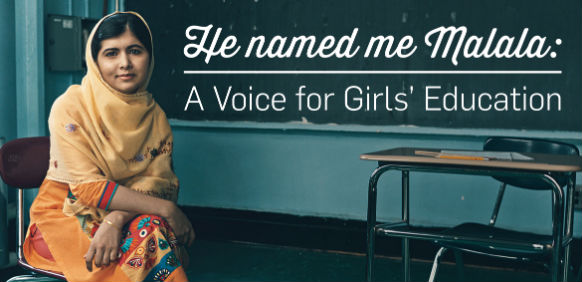MALALA: THE BULLET AND THE QUEST FOR WOMEN’S EDUCATION

Nagsen Torne is a graduate in Bioanalytical Sciences from Ramnarain Ruia College and is currently pursuing a Masters degree in Public Policy Analysis. He is a kickboxer and also a bibliophile who loves learning. He believes that a pen, a few words and an idea can bring about the greatest of social revolutions.
MALALA: THE BULLET AND THE QUEST FOR WOMEN’S EDUCATION
There’s a moment when you have to decide whether to be silent or to stand up.
– Malala
On October 9, 2012, in Swat Valley in Northern Pakistan, which is known for its picturesque mountains, a school bus was carrying few girls home from school. Amid the playful chatter, the bus came to a sudden stop and two men boarded the bus with guns. One of them demanded to know which girl was Malala. A modest girl in the corner stood nonplussed on hearing her name in the confusion. When her friends looked towards her, her location was given away. The gunman fired three shots at her with a Colt 45, hitting her in the left side of her forehead; the bullet then travelled down her neck. Two other girls, her friends, were also injured in the attack.
One day later, as she lay in a medically induced coma in a hospital in Peshawar, Pakistan, her condition suddenly deteriorated and her doctors did not know whether she would live or die. A certain Pakistan Army general, Gen. Ashfaq Parvez Kayani, who had met the girl during previous visits to Swat, immediately realized this was not just another attack in a district where the Taliban still held considerable power. “He recognized that she was a symbol,” says Dr. Javid Kayani, a deputy medical director of University Hospitals Birmingham, who happened to be in Islamabad for a meeting with the army chief that day. “He knew that if her life had been extinguished, then that would be a victory to the forces of darkness.”
She was moved in an army helicopter equipped with ICU unit to a military hospital in Peshawar, then to Rawalpindi and later to a hospital in Birmingham, England.
In three days, the girl’s name was on every major news program across the world. The Taliban claimed credit for attacking her and promised to finish the job. The military surrounded the Rawalpindi hospital with soldiers. Snipers were posted on the roof. Her country and also the whole world knew that losing her would mean losing to the enemy, losing to the parochial view the enemy advocated. Offers poured in from the United States, the United Kingdom, the United Arab Emirates and other countries, offering admittance to specialized hospitals where the girl would not only be cared for but could also begin the slow process of retraining her damaged brain. The army and the doctors, to avoid politics, came to a consensus to move her to Birmingham.
The 15-year-old would survive to become a global icon of courage and an international ambassador for girls’ education. Malala Yousafzai, who would go on to be the youngest person ever to win the Nobel Peace Prize, had survived the Taliban bullet.
How the Taliban came to fear a schoolgirl:
The 15-year-old had inherited activism at an early age of eight from her father, an educationist, who ran a local public school. After the Taliban began attacking girls’ schools in Swat, Malala gave a speech in Peshawar in September 2008. The title of her talk was- “How dare the Taliban take away my basic right to education?” Her activism continued in the form of writing a diary blog for BBC Urdu. The seventh grade school-girl chronicled how the Taliban fatwas affected her and her classmates under the pen name Gul Makai. If the pen name was meant to keep her identity secret, it certainly did not work. By mid-February, the New York Times had already aired a short documentary featuring Malala and her father and their struggle to sustain a girls’ school under the Taliban in Swat.
With a growing public platform, Yousafzai continued to speak out about her right and the right of all women to an education. Her activism resulted in a nomination for the International Children’s Peace Prize in 2011. That same year she was awarded Pakistan’s National Youth Peace Prize. This, she had accomplished, right under the nose of Taliban in Swat. The Taliban took it as an insult and death threats became common for Malala and her family.
Whatever destiny her country was hurtling towards, there was one thing standing between Pakistan and the Taliban’s dream of heaven on earth: the number of women who had been to school, and the number of women who couldn’t go to school but were determined to send their daughters to school, no matter the economic imperative. An educated girl like Malala was everything that the Taliban feared. The extremists feared gender equality more than the American drones. The logic, for them, was simple. Empowered women would never accept the brutal ideology espoused by terrorist leaders as the rule of their land. Educated women and girls would fundamentally challenge the power structure of organizations like theirs. Therefore, to carry out the argument, they would have to be suppressed and enslaved.
The question: Why do these groups target women? It all comes down to asserting control. Often times, extremist groups are catering to disillusioned young men who, because of their unstable life circumstances, have been unable to marry, secure a job, provide for a family and thus assert their masculinity in traditional ways. Hence, the control over and subservience of women is part of the messaging and ideology that seems to resonate well.
“When the Taliban shot Malala, they showed what they feared most: a girl with a book,” Ban Ki Moon, secretary general of the United Nations, said during the Youth Assembly held on 12 July 2013 in New York, where Yousafzai addressed nearly 1,000 delegates from across the globe. She celebrated this day at the UN with her family and she delivered a wonderful speech at the UN to call for worldwide access to education. It was her first public speech since the attack. So the UN has officially announced 12th July as Malala Day to support a world at school.
The Journey Ahead:
Malala was featured in the 2013, 2014 and 2015 issues of TIME magazine as one of “The 100 Most Influential People in the World”. Her bravery has won her the 2013 Sakharov Prize. She has also written an autobiography, I Am Malala: The Girl Who Stood Up for Education and Was Shot by the Taliban, which was released in October 2013. In February 2014, she was nominated for the World Children’s Prize in Sweden. She was granted an honorary doctorate by the University of King’s College in Halifax, Nova Scotia in May 2014. Later in the same year, she was announced as the co-recipient of the 2014 Nobel Peace Prize, along with Kailash Satyarthi, for her struggle against the suppression of children and young people and for the right of all children to education.
Malala went on to start “The Malala Fund” for women education. This fund works toward and believes that free, safe and quality education is the right of every girl. A documentary revolving around her life, “He Named Me Malala“, was critically acclaimed and was also nominated for BAFTA awards.
For her 18th birthday on July 12, 2015, on Malala Day, the young activist continued to take action on global education by opening a school for Syrian refugee girls in Lebanon. Its expenses covered by the Malala Fund, the school was designed to admit nearly 200 girls from the ages of 14 to 18. “Today on my first day as an adult, on behalf of the world’s children, I demand of leaders we must invest in books instead of bullets,” Yousafzai proclaimed in one of the school’s classrooms.
Malala is the hero who created a domino effect of change, bringing attention and empowering girls and boys alike to act on the issue of universal education, a sustainable development goal adopted by United Nations to be accomplished by 2030. She is a brave girl, a role model in this troubled times for the girls in war-torn countries, for girls kept away from education, for girls deprived of their rights. In her short life so far, Malala has demonstrated immense passion for education equality for girls, so much so that she continued fighting for her cause even after receiving death threats from the Taliban. Malala’s body could have easily given up after receiving a bullet to her brain. But she fought on. Her body is that of a survivor, with her resilient spirit, which continues supporting her cause long after recovery.
Malala, which in the pashtun language means grief, owes her name (which was inspired by a brave Pashto girl whose courage propelled tribal warriors to take on imperialist armies) to her visionary father, Ziauddin Yousafzai, who is himself a tireless campaigner against Taliban fundamentalism. But as she herself says, he didn’t “make” her Malala—or propel her into danger. She did it of her own volition, and having survived the Taliban’s guns, is taking her message to newer displaced communities, from Palestinians to Syrian refugees to Nigeria overrun by Boko Haram madness.
Every girl who walks to school, who crams for a high-school exam, every woman who runs a hospital, and every semi-educated mother who makes sure her daughter gets a better education than she herself received, is a mortal threat to the extremists’ declared ambition and in turn, unknowingly, is making this world a better place to live in.

